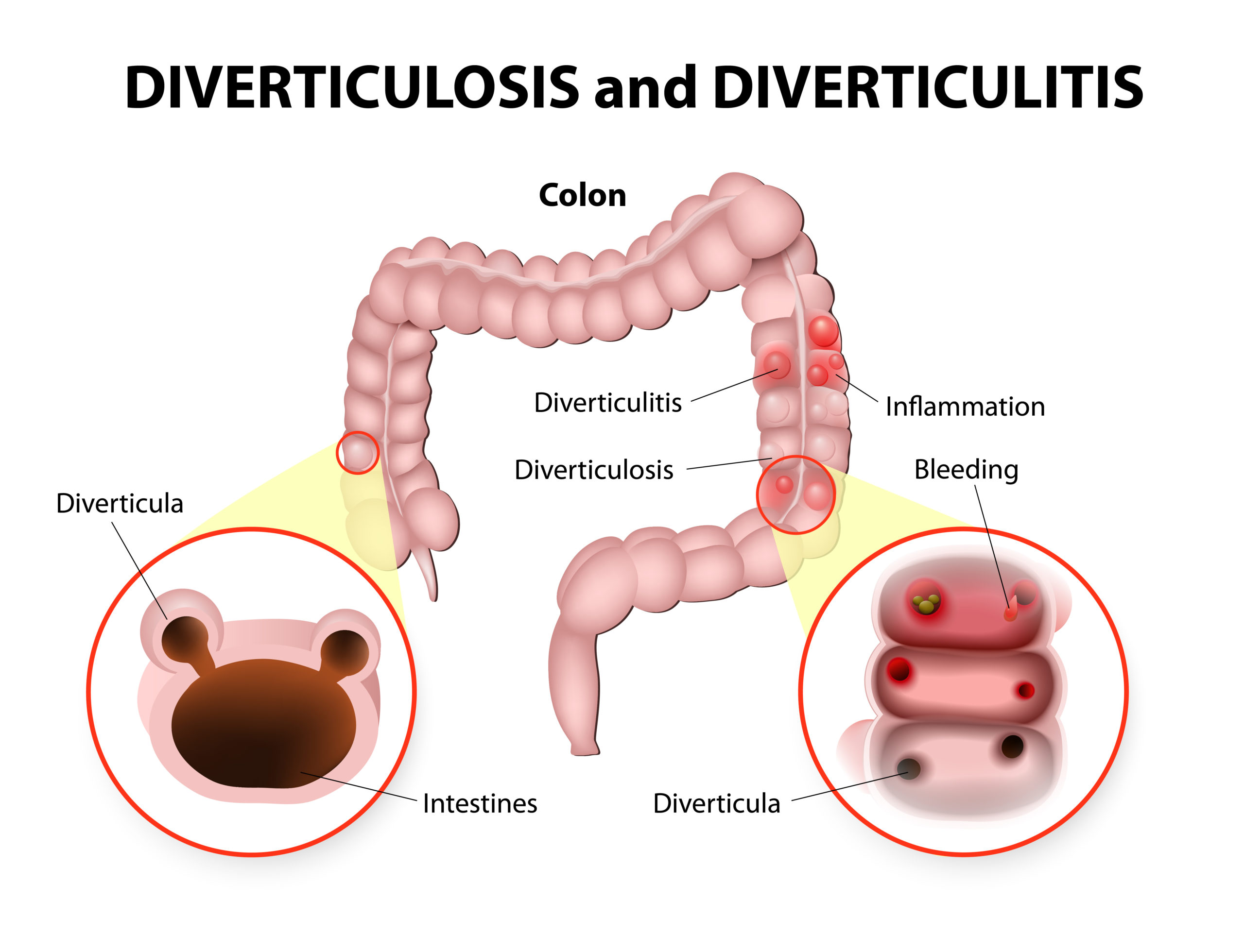
Prevalence of Diverticular Disease
Diverticulitis is the inflammation of sac-like protrusion in the colon (known as diverticula).
While it is uncommon for those under 40 years of age, around 40% to 66 percent of those over 80 years old will have some level of diverticular pockets.
Of these, around 20 percent will have develop diverticular disease (where they will experience some symptoms related to this) and around 1% to 4% will have acute diverticulitis (1).

Classification of Diverticular Disease
Giovianni M (2) provided a diagrammatic classification of Diverticular conditions given below.

Thus it is important to know what these particular terms mean, since the symptoms and manifestations of these categories will determine how each condition is treated, including the type of dietary intervention required.
Diverticulosis: the presence of diverticula
Diverticular disease: any symptomatic condition involving diverticula
Diverticulitis: diverticular macro inflammation with local pain symptoms
Complicated diverticulitis: abscesses, fistulae, obstructions or perforations
Symptomatic uncomplicated diverticular disease: diverticula with persistent localized pain and diarrhoea/constipation, without macroscopic inflammation (interestingly enough, this can be misdiagnosed as Irritable Bowel Syndrome as the symptoms are very similar).
Causes of Diverticular Disease
While it is not exactly known what causes the development of diverticula, the following have been reviewed by Ceveri C et al (2018) (ref 1).
Pre-disposing factors include having a high BMI, waist to hip ratio, bigger waist circumference, eating of red meat, smoking and also having red meat and also some drugs such as NSAID or Aspirin.
Protective factors including high fibre diet, increased vitamin D levels, high level of exercise.
To be confirmed include the role of genetics, age, gender and alcohol intake.
They have stated as irrelevant consumption of seeds, nuts, grains (but my patients' experience shows that in during a diverticulitis episode, avoidance of these can help).
Management of Diverticular Disease / Acute Diverticulitis
Ceveri et al (1) provide a guideline for management of acute diverticulitis combining the Modified Hinchey Classification and the German Society of Gastroenterology Classification (given below).

Dietary Management of Acute Diverticulitis and Diverticular Disease
The dietary management of diverticular disease depends on the classification of the symptom one has. Thus the right dietary management can lead help to manage symptoms and hopefully prevent flare-up.
As such, Maximised Nutrition has developed nutrition education program (available for NZ$49) that can help you to manage diverticulitis flare ups at home. Please note that if you have any bleeding or unmanageable pain, please consult your GP.
This nutrition education program will teach you:
* how to manage your symptoms through a 5 phase dietary management guide.
* how to adapt your every day meals for a diverticulitis episode.
* what to eat and what supplements to use in order to meet your recommended daily requirements.
Professionally designed and nutritionally analysed gender/ age Specific menu and recipes are included - It is very important to have an optimal nutrition during a diverticulitis flare up.
This comprehensive program costs $49 only. Remember to see a registered dietitian, you will be paying anywhere from $150 to $260 an hour. Whereas, this program is worth at least $199.
Click below to go to the program now:
What's Unique About This Program?
Most information given online tells you about going on a low roughage diet for diverticulitis. However, note that depending on what type of diverticular symptom you have, you may need a specific dietary intervention. Also, even if you do go on a low roughage diet, how do you know that you are getting all your micronutrients while you restrict your roughage? Cutting back fibre and fibre foods do cut back on micronutrients.
Thus this program has a nutritionally analysed recipes and menu that is appropriate for your gender and age. AND also has been analysed for the three countries: New Zealand, Australia and USA.
There are four modules and each module unlocks key aspect of how to manage diverticular disease according to your symptoms from acute flare-ups to the well stage, hopefully, with the right management, you will get less of the flare-ups.
Click below to find out more about this amazing program.
References
1. Ceveri et al: Recent advances in understanding and managing diverticulitis. F1000Research 2018, 7(F1000 Faculty Rev):971 Last updated: 29 JUN 2018
2. Giovianni M: Diagnosis of symptomatic uncomplicated diverticular disease and the role of Rifaximin in management Acta Biomed: 2017; 88(1): 25–32.
Copyright 2021 Maximised Nutrition Ltd